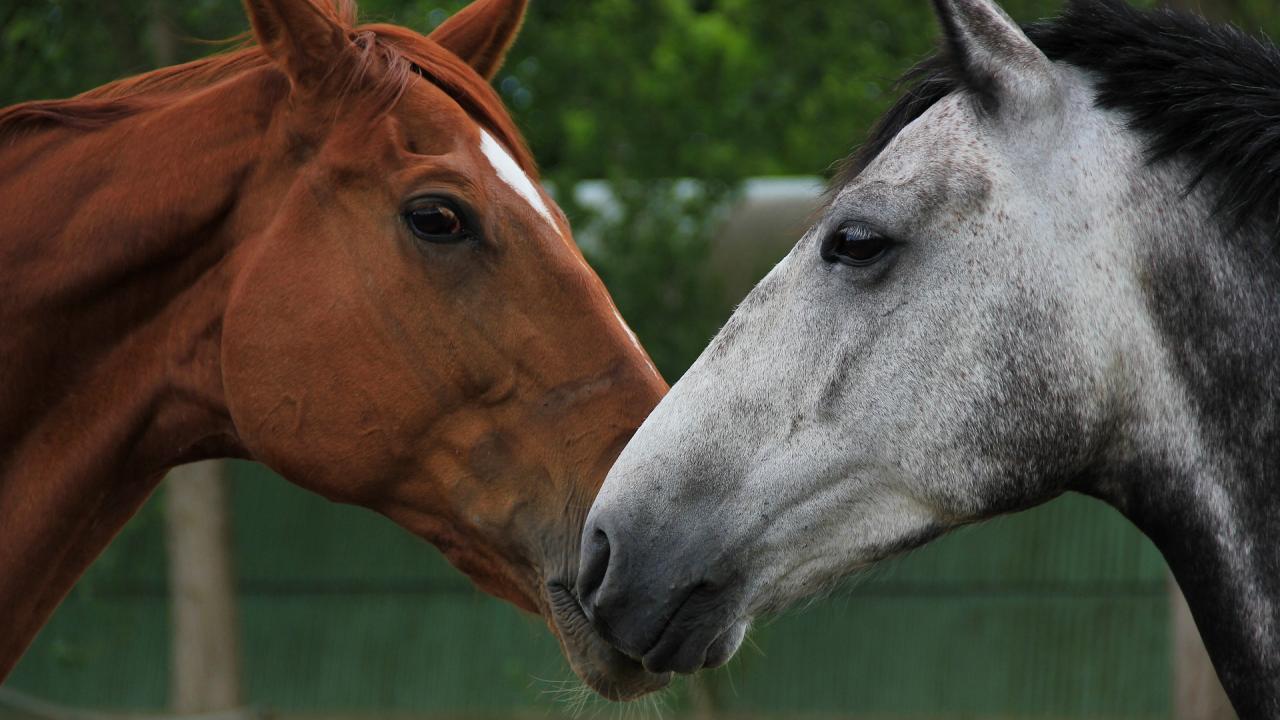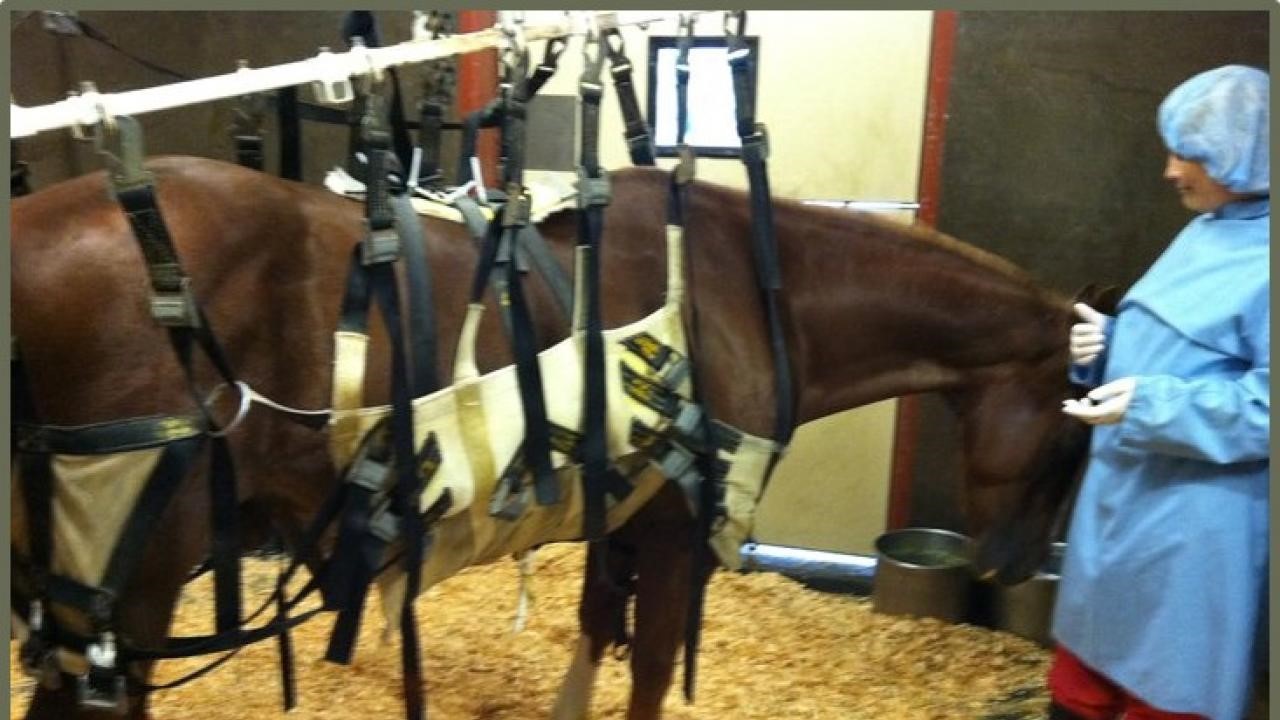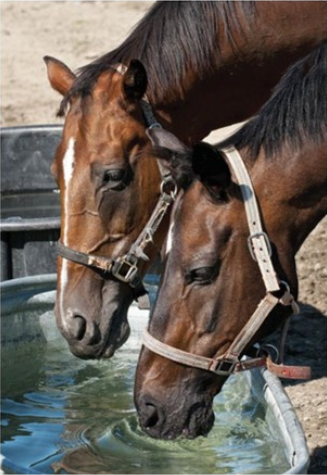
Equine Herpesvirus 1 (EHV-1), Equine Herpesvirus Myeloencephalopathy (EHM)
What is equine herpesvirus myeloencephalopathy?
Takeaways
- Equine Herpes Virus 1 (EHV-1) has four forms, causing respiratory infection, neonatal infection, abortion, or neurological signs. The last form can cause Equine Herpesvirus Myeloencephalopathy (EHM).
- The virus is spread by horse-to-horse contact, contaminated hands, equipment, and tack, and can also be transmitted for a brief period in the air in the immediate environment.
- Infected horses that do not show clinical signs act as carriers and can shed the virus.
*Click here for a list of EHV-1/EHM FAQs.
Webinar for veterinarians (April 2021)
Webinar for horse owners (April 2021)
Equine herpesvirus-1 (EHV-1) is one of a large group of DNA viruses that causes potentially serious disease in horses and other species. EHV-1 has four forms, causing respiratory infection, neonatal infection, abortion, or neurological signs. The last form can cause a condition known as Equine Herpesvirus Myeloencephalopathy (EHM), which attacks the spinal cord and brain and can be fatal.
The virus is spread by direct horse-to-horse contact, by contaminated hands, equipment and tack, and, for a short time, through aerosolization of the virus within the environment of the stall and stable. Infected horses that show no clinical signs, which often includes older horses, act as carriers and can shed the virus.
What are the clinical signs of equine herpesvirus myeloencephalopathy?
The initial clinical signs of the infection may be nonspecific and include fever of 102°F or greater. Fever may be the only abnormality observed. Other presenting signs may be combinations of fever and respiratory signs of nasal discharge and cough. Some horses have injected (i.e. bright red) mucous membranes.
Horses with neurological disease caused by EHV-1 infection can quickly become uncoordinated and weak and have trouble standing. Difficulty urinating and defecating may also occur. Often the rear limbs are affected more severely than the front, which results in dog-sitting and toe-dragging. Signs of brain dysfunction may occur as well, including extreme lethargy and a coma-like state.
The incubation period of EHV-1 infection is HIGHLY VARIABLE, depending on the host, on the virulence of the virus, and on environmental and other factors such as stress. The AVERAGE incubation period is 4 to 7 days, with the majority of cases being 3 to 8 days, but with some taking up to 14 days. When neurological disease occurs, it is typically 8 to 12 days after the primary infection involving fever.
How is equine herpesvirus myeloencephalopathy diagnosed?
EHV-1 is commonly diagnosed from nasal swabs or blood samples by polymerase chain reaction (PCR), which amplifies the DNA of the virus so that it can be detected. In California, EHM is a reportable disease and therefore the California Animal Health and Food Safety Laboratory (CAHFS) must be used to perform EHV-1 testing in suspected cases. Positive cases tested at a none-state diagnostic laboratory need to be confirmed by CAHFS. The laboratory recommends submitting both a nasal swab sample and a blood sample if possible. A nasal swab sample is the more desirable of the two if only one sample can be submitted. Depending on when the sample is received, it is possible to receive same day delivery of test results.
Since the positive predictive value (the relationship between those individuals who test positive to the number of those testing positive that actually develop clinically significant disease) of PCR-based tests for EHV-1 in asymptomatic horses is uncertain at this time, horses outside of quarantine areas or in unexposed stables should not be tested on a random basis. The finding of a positive PCR test result in an asymptomatic horse does not provide conclusive evidence of either active infection or the potential for disease transmission, because low levels of nonreplicating virus may be the source of the viral DNA detected. This means that the detection of virus through PCR analysis does not provide a diagnosis in the absence of clinical signs and/or of other corroborating information. Therefore, the use of this technology as a screening tool for EHV-1 in clinically normal, nonexposed horses is considered inappropriate.
Since EHM is a reportable disease in most states, please contact your state animal health officials if you suspect EHV-1, especially if associated with neurologic clinical signs.
How is equine herpesvirus myeloencephalopathy treated?
Horses that exhibit sudden and severe neurological signs consistent with EHV-1 should be isolated immediately to prevent the spread of infection to other resident horses. Since EHV-1 is a virus, antibiotics will have no effect and antiviral drugs have shown minimal effect in already affected horses. Treatment is primarily supportive, and usually includes anti-inflammatories and fluids to maintain hydration. Slings may be used to help horses that are unable to stand on their own.

What is the prognosis for equine herpesvirus myeloencephalopathy?
In most cases, horses exposed to EHV-1 will develop a fever and possibly nasal discharge and then go on to recover. However, the neurologic EHM strain has a high mortality rate of 30-50%. Recovery time can vary from several days to more than a year. Horses that are able to remain standing usually have a better prognosis than those that are recumbent.
How can equine herpesvirus myeloencephalopathy be prevented?
Transmission of EHV-1 can occur through infected droplets spread by coughing from infected horses and through nasal secretions. Contaminated hands, clothing, shoes, equipment, and tack can spread the virus. Horses can be carriers even if they do not show clinical signs.
It is important to isolate sick horses and determine the cause of their neurological deficits as quickly as possible. Try to determine if the horse has been around horses that may have been in a place with documented EHV-1 cases. It is always a good idea to isolate horses with fevers since infections other than EHV-1 can also be spread by horse-to-horse contact.
Notify your veterinarian immediately if your horse develops fever, respiratory signs or neurological signs, and do not move the horses in the immediate area. Cease all movement of horses in and out of the facility until a diagnosis is confirmed by testing to prevent the spread of the infection to other locations.
Once a diagnosis of EHV-1 is confirmed, the state veterinarian will become involved in California. Focal quarantine measures will be required to prevent the spread of disease. Initial restrictions may include the quarantine of individuals in the immediate area of exposure (i.e., a single barn). These horses should be monitored closely. EHV-1 testing is warranted only if they exhibit fever or clinical signs consistent with EHV-1 infection. Since stress may trigger the onset of clinical signs, horses in areas of known exposure should not be subjected to strenuous physical exercise or long-distance transport until their health status can be determined.
An additional focal quarantine should be instituted if new clinically ill or EHV-1 positive horses are identified in other locations within the facility. If multiple cases are identified or suspected, the entire stable area may need to be quarantined. The optimum strategy should be the prudent imposition of a series of focal quarantine procedures using an expanding series of “concentric rings” of disease control.
Individuals that have tested positive for EHV-1 within the designated quarantine area, whether symptomatic or not, should be retested periodically until disease is confirmed or eliminated based upon both a PCR test and a lack of clinical signs for the disease. Quarantine measures should be maintained until an absence of further clinical cases and positive tests suggest no new appearance of disease is occurring. At that time, a gradual drawdown of these procedures can be applied. Areas of the facility under focal quarantine may have their restrictions rescinded in reverse of the concentric-ring approach. Isolation protocols are recommended to remain in place for 21 days after confirmation of new EHV-1 cases.
EHV-1 does not persist in the environment for a long time, but it is important to disinfect all premises, stalls, trailers, etc. A solution of 1 part chlorine bleach to 10 parts water is effective for decontaminating equipment and the environment. It is important to wash your hands and change clothing if you handle a horse with EHV-1 to prevent infecting other horses.
Horse owners, riders, grooms, and trainers are advised to follow these basic biosecurity guidelines to decrease the potential spread of EHV-1/EHM at equine facilities and events:
- Limit horse-to-horse contact
- Limit horse-to-human-to-horse contact
- Avoid use of communal water sources
- Avoid sharing of equipment unless thoroughly cleaned and disinfected between uses
- Monitor horses for clinical signs of EHM, including fever of 101.5oF or greater, nasal discharge, cough, reddish mucous membranes, puffy and red eyes, swollen legs and acute onset of neurological signs (ataxia, recumbency, urinary incontinence)

Although vaccines are available for the respiratory and abortion form of EHV, there are currently no vaccines for EHM. There is currently no consensus in the veterinary community as to the effectiveness of EHV-1 vaccines. Consult with your equine veterinarian for questions about EHV-1 vaccination.
For more information:
California Department of Food and Agriculture (CDFA): Equine Herpes Virus
Wright, C.A., Lawton, K., Barnum, S., Craig, B.W., Farwell, B.R., Blea, J., McCook, C., Pusterla, N. 2025. Investigation of the role of exercise in the detection of selected respiratory pathogens from nose wipes collected from healthy horses. J Eq Vet Sci 146:105377.
Center for Equine Health Horse Report (Spring 2018), “A Deadly Strain of Equine Herpes Virus”
UC Davis School of Veterinary Medicine News – A Deadly Strain of Equine Herpes Virus
*This article may not be reproduced without the written consent of the UC Davis Center for Equine Health. Please email requests to cehadmin@ucdavis.edu.
